Constant impermanence
To live in the developing world is to life in a state of hyper-change. Everything changes all of the time, without warning and generally without any fuss – because everyone has simply come to expect impermanence. Impermanence of services. Impermanence of the physical surroundings. Impermanence of people. For these things to constantly change is the norm.
The power comes and goes.
Sure, there is an approximate load-shedding schedule that is fairly reliable for a couple months of the year (load-shedding is the practice of scheduled power-outages for different parts of the grid at different hours because the load of the full grid at any given time is beyond the capacity of the power source). But the power can and will go off unexpectedly for unpredictable spans of time throughout the day. Sometimes just for a couple minutes, sometimes for an hour – and sometimes for a few weeks. Such as when I returned home from trekking in January: apparently a transformer blew and a quarter of town hadn’t had power for a fortnight.
The water comes and goes.
Naturally part of this is due to seasonal fluctuation. In the village it’s almost entirely due to this, but in the cities it’s also due to infrastructure limitations and malfunctions. Much like power, public taps are on a rough schedule of availability; in order to manage limited supplies, the taps only flow for a couple of hours each day. But sometimes water simply doesn’t come. Did the tanks run dry? Was there a leak somewhere along the unburied pipe? Did the man who controls the flow simply not show up to work that day? And the condition of the water depends upon the season: if there’s been a heavy rain, you can expect the tap water to arrive quite cloudy because it is delivered from tanks fed by streams without any filtering or treatment.
The roads are different day-to-day, month-to-month.
Around the city, roads are constantly being dug up, filled in, paved over and re-dug for water pipes or storm drains or what-have-you. During monsoon, the savvy pedestrian learns which intersections are most likely to be flooded and thus which alternative routes to take in order to avoid them. But they surely won’t be the same next year, after new trenches have been dug and the storm-drain bottle-necks have shifted. Outside the city, the narrow highway becomes impassable at the occurrence of a single accident, however minor. During monsoon landslides gradually consume the highway, gobbling up bits and pieces as they please – bits and pieces which the road crews will spend months laboriously repairing once the rains have ceased, only to be consumed once again the following year. Even without accidents, natural obstructions or construction the public transportation fleet varies greatly in age, maintenance and speed and thus the duration of any given bus ride along a consistent route is completely variable bus-to-bus. Compounding this fact, the public transportation social system simply functions differently here – efficiency and schedules are not the drivers’ priority. Filling the bus to it’s maximum capacity is. Buses will sit for an hour waiting for someone to reach the station or to load their twenty sacks of rice or a dozen goats. It will stop to let more people on even when you are absolutely convinced it is impossible to fit more people in the bus. In general, it’s best to expect at least one out of every three vehicular trips to be held up somehow and to give yourself an hour leeway for reaching your destination.
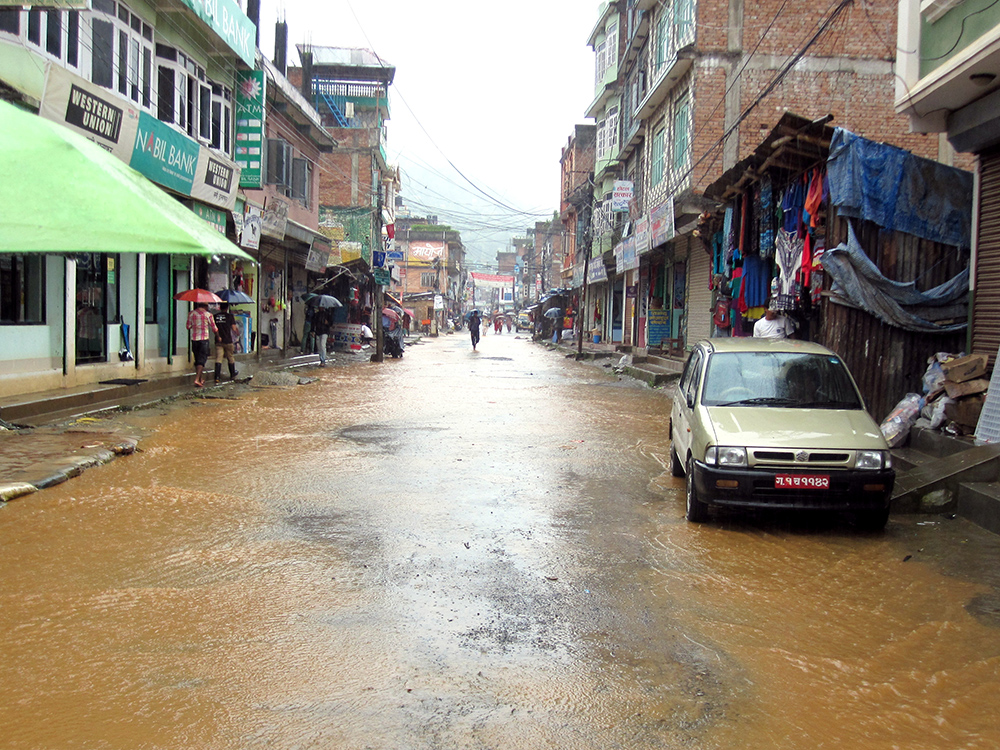
Monsoon: flooded streets of Baglung
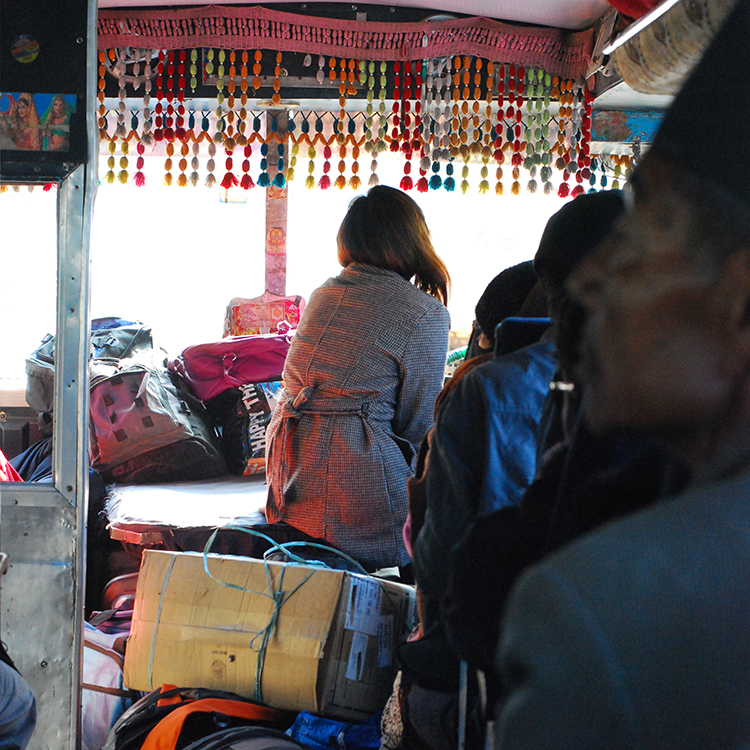
Confirming an appointment requires multiple reminders, affirmations and last-minute shifts.
Dates for meetings are set and moved back, again and again. Even regular meetings, such as the monthly staff meeting at the Agriculture Development office, usually don’t have firm dates only gentle guide lines such as “around the first of each month.” This means sometimes the meetings are held on Sunday the 28th, other times on friday the 4th. The actual date is seldom set more than 2 days in advance. Often an officer will say they are available “bholi-parsi” (tomorrow or the next day), but upon next day inquiry they very well could be in Kathmandu. Additionally, I have found that most officers are uncomfortable (even at times unwilling) to commit to an appointment more than 1-2 days before. Thus calling on a Monday to set an appointment on Friday – good luck. They usually tell you to call again on Friday morning. You can imagine the difficulty this creates for setting up meetings in cities that are more than a day’s distance from my site, such as in Kathmandu…
The informal economy, however well-organized, is ever-shifting.
Food carts on wheels are, by design, portable. You think you know where to expect them, but then one day for seemingly no reason at all they are gone never to be seen on that street again – or show up two hours later than they used to. On the same foot, they sometimes show up in unexpected places at unexpected times, serendipitously providing a snack when one needs it most.
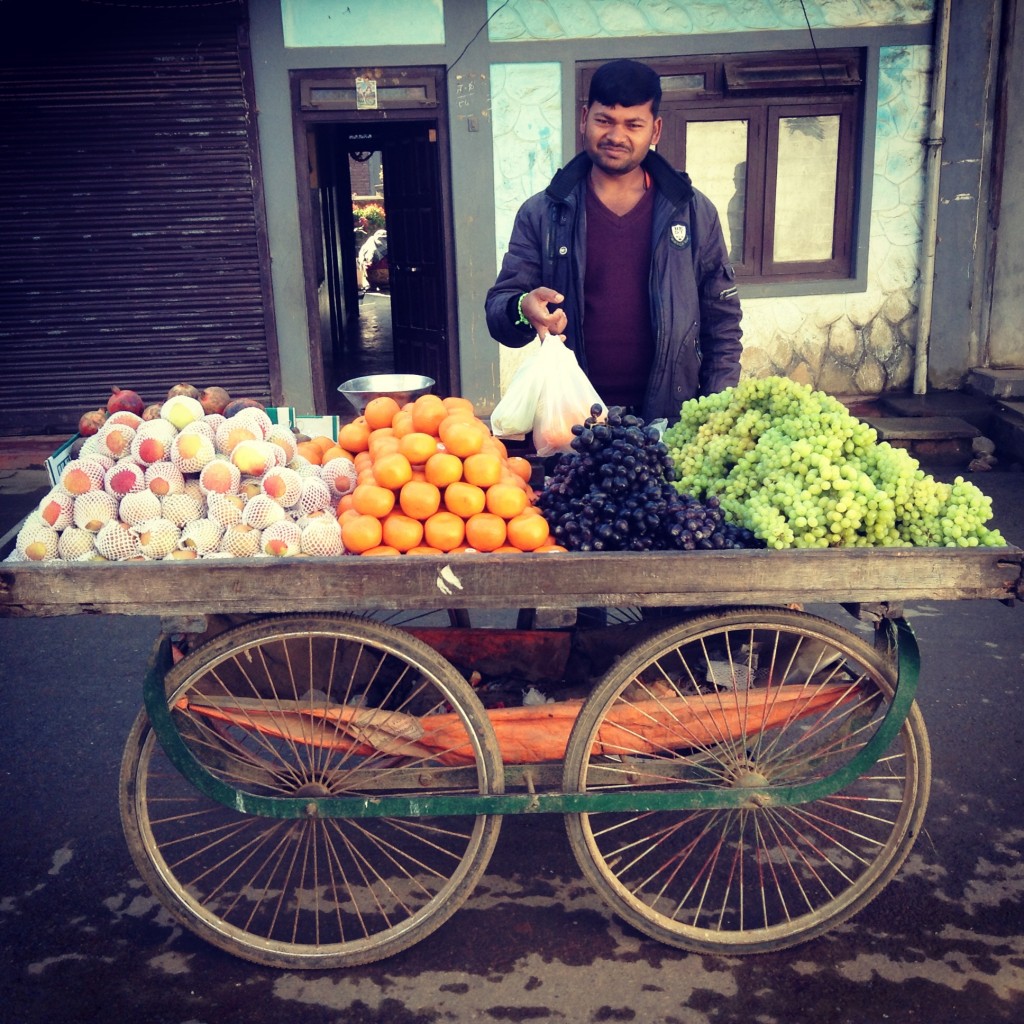
Construction is on-going.
Around a corner, in a vacant lot where there had once been a kitchen garden or a simply-constructed carpenter shop (a tin roof and just enough siding leaned up against a frame to keep things beneath relatively dry) – there’s suddenly a shotty concrete foundation and pillars, yet another new building rapidly going up. One day walking through town, you find yourself curious about just how many buildings are going up at once within the bazaar’s small two square miles, and you realize that there are practically zero blocks without at least one construction site. Along with them comes a slew of additional fluctuations: piles of gravel, mounds of dirt, stacks of rebar, generator-driven concrete-mixing machines occupy the street in turn, forcing all traffic to carefully pick their way around, adding various textures to the cities audio tapestry. On the next block, that restaurant that you always went to because it served giant pots of tea has become – a tractor show room.
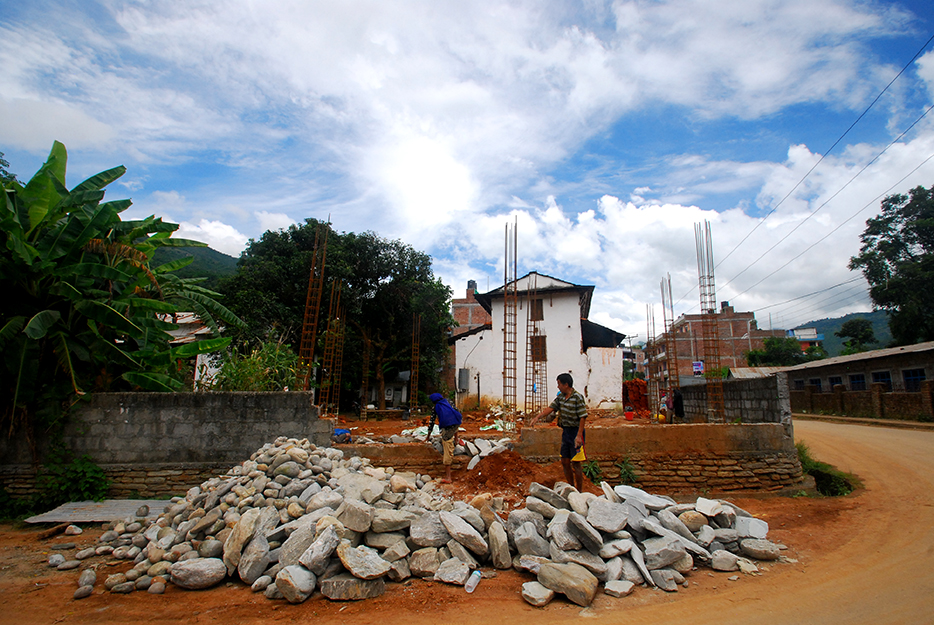
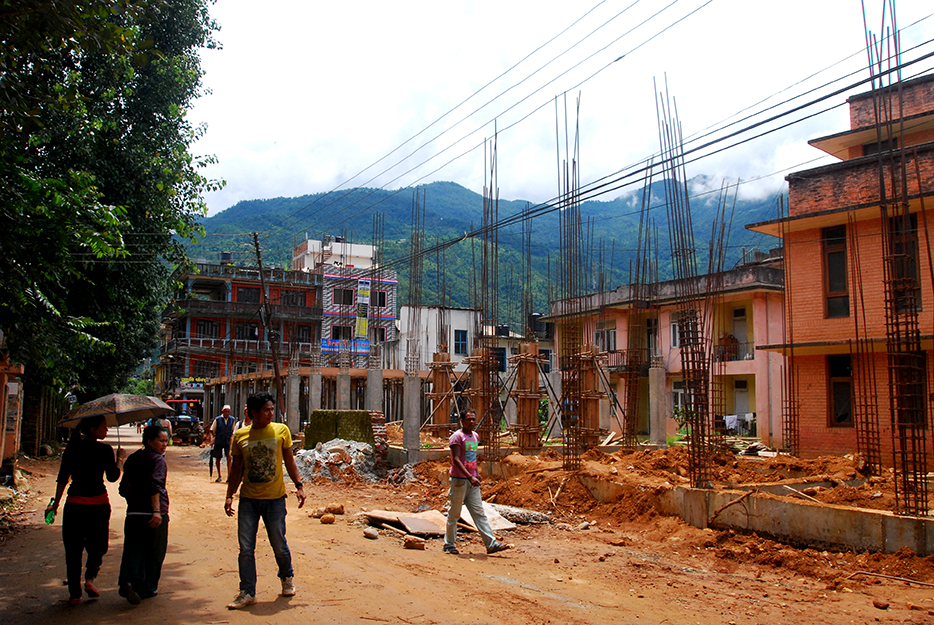
People come and people go.
Hyper social change is constant turn-over and many departures without ceremony.
- Returning home after a week away to discover that the waiter at your usual tea shop has quit and left town with no warning nor good bye. (The waiter who knew you by name, who had become your friend of sorts.)
- Returning home to discover one of my first neighbor friends – the one who’s husband left her for a second wife, as discussed in another blog post – had left to Kathmandu to learn Japanese, in hopes of obtaining a visa to work in Japan. I’ve no idea when she’ll return or even if she’ll return, or will instead simply leave for Japan.
- Returning home to discover your host sister had moved to Kathmandu to study for her bachelors degree and no longer lives in your house.
- Returning home after a week away to discover that the young mother who lived across the hall is gone without a trace, and in her place five men have moved into all four other rooms on your floor.
Home.
In the fifteen months that I lived in Uppalachaur, I shared the second floor with over fifteen different occupants, and each time one has come or gone it has been completely without warning nor salutation. Locks added to new rooms, new welcome mats outside each door, new soap stuff and buckets in the wash-room. Family storage shifting locations and condensing again and again, until eventually even my bicycle was kicked out of the once spacious and unlocked downstairs storage to live in the hall, beside one of my family’s old cabinets that had also been displaced from its former resting place. Each time they shifted their store-room, the cockroaches ran for cover under the first available door they could scamper. The day someone moved in across the hall from me at 6 in the morning – let’s just say half the day was lost to a cockroach massacre….
With the latest shift of boarders – the five men who spread into all of the remaining rooms – six people shared one toilet and, more intensely, one wash room. More intense because the wash room serves for all washing purposes – person washing, dish washing, cloths washing – everything kept inside the house that requires washing. The building had always had plenty of water before, but with the demands of washing so many things for so many people the store tanks began to regularly run dry. Laundry became a race – whoever occupied the washroom sooner would get the water. The sucker who tried to do laundry late would have to postpone to the next day..
And then – Peace Corps decided that I had to move out, for my personal safety. PC safety standards require female volunteers‘ households to be no greater than 50% male. With the five new male housemates and one less female, the household ratio had become 7:2, male:female. At first I found this news rather annoying and frustrating. I mean, the timing could not have been much worse – in the middle of the busy spring season while I had several projects in full swing and more I was eager to launch. The process of moving – of finding a room and new family that met Peace Corps strict standards, getting the room approved by staff, packing, moving, resettling – would require a lot of time and be a huge disruption to my work. But after I let it sink in for a few days I came to accept it as in my best interest. Even without the male-to-female ratio violation, my family had been growing less and less familial. Food had become a source of increasing tension – my host mom was becoming more and more passive-agressive, making false assumptions that I was not following her strict rules and getting angry with me rather than asking directly about them (rules such as not entering the kitchen during menstruation). And she became unwilling to cook for my friends when they stayed over (which is very out of line with Nepali people’s usual hospitality). They never initiated communication with me about my whereabouts or their own plans to be away, but they’d complain to me about not knowing where I was. In all honesty, I had resigned myself to deal with these things on the grounds that they weren’t effecting my ability to work nor my general happiness.
After a month-long process of searching, paperwork and a formal visit, I was granted permission to move in with a new family in the middle of town – in the middle of a hustling little Nepali bazaar. The room is spacious and clean, I’ve been able to set up my own mini-kitchen, and – I’ve actually found a family that’s warm and willing to take me in as their own. And though I honestly wasn’t searching for the latter – I really just wanted a comfortable room to set myself up in – I have found it to be a very pleasant aspect of my move. Something that I was perhaps missing without realizing it: the feeling of being genuinely welcome.
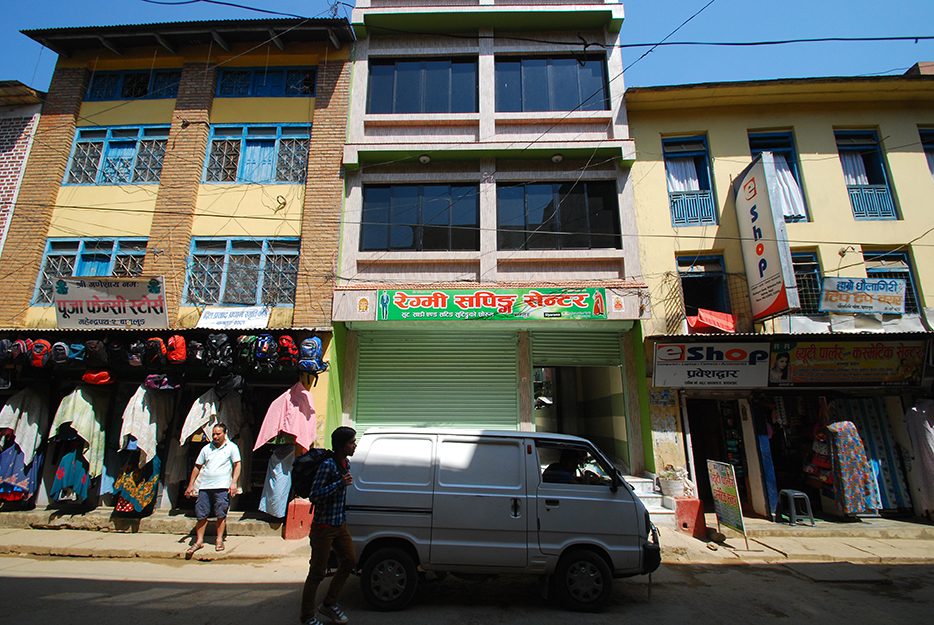
Walls come and go.
Even the most obscure of property lots are owned by somebody. Even tiny triangular lots squeezed between two existing buildings in the middle of a small college campus. Sometimes those owners suddenly decide they want to build on said lots. And in order to do so, walls must come down. This is the story of what has come of my women’s empowerment mural. Yes, someone has decided to build directly behind it, and thus my mural had to come down – or, more precisely, half of it did. And I can proudly, honestly tell you that I had zero reaction when I first learned this news. Zero reaction because – the mural had already done so much. The mural was the product of a process, of working with community members to create something, of promoting a message. And the mural certainly made splashes, both within Baglung and far far beyond. The Peace Corps Nepal office loved it, so they requested me to write a formal report on it which was then sent to our Head Quarters office, who in turn posted an image of the mural on their FB page banner. (check it out!). From there, it was shared over 400 times – surely across other PC volunteers pages, who are connected to nationals of countries all over the world. My mural, and it’s message of strength and encouragement, has been around the world and back. And so learning that the physical mural would be half-destroyed truly did not phase me.
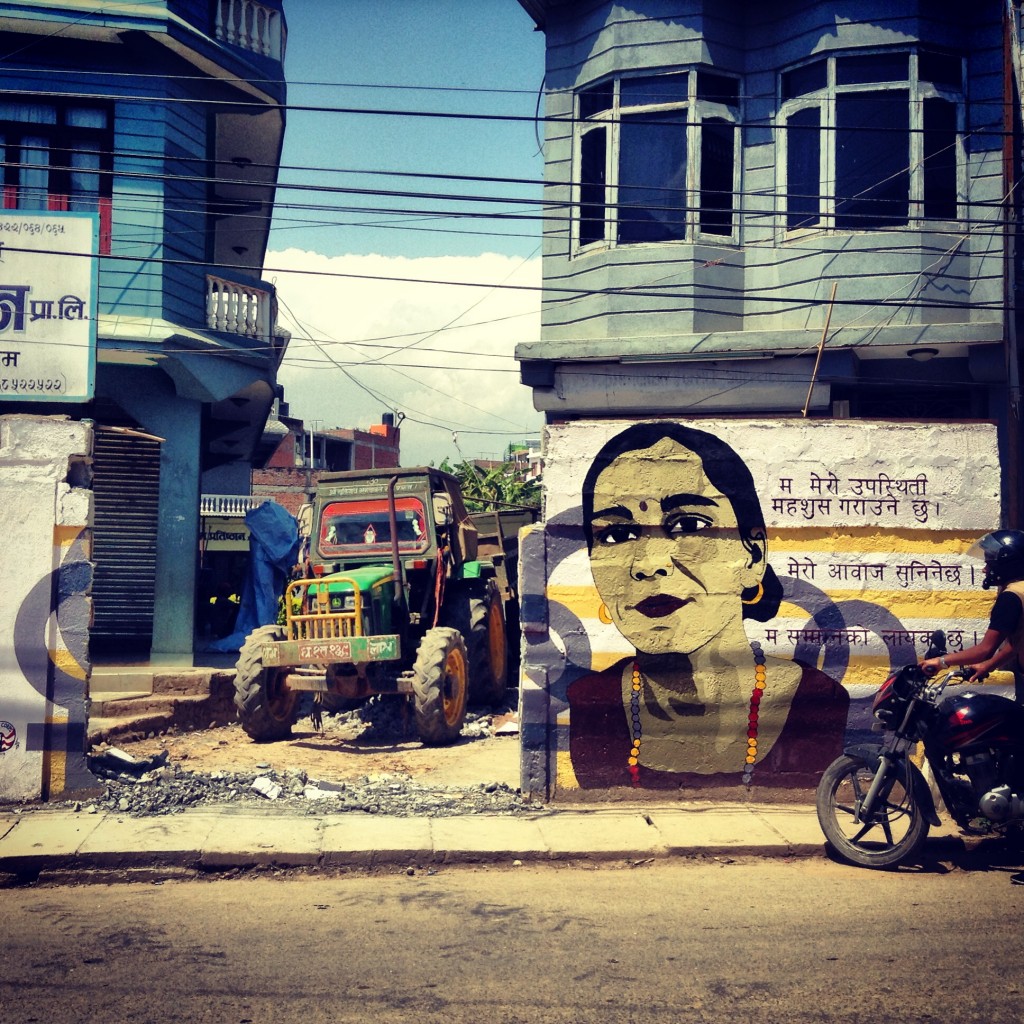
And then – with the destruction came new meaning. Only the left-half was destroyed, leaving the portrait of the woman standing tall and strong. It’s as if she defied an attempt to defeat her. She is a survivor in this place of constant turn-over. I will return to her next week to refresh her message – to add the statement: “I am resilient”.
– – –
Here, as with life, I may only predict that things will continue to change. And so the best I can do is learn how to roll with the punches as they say; to enjoy the new depths my patience has reached; to embrace change and the unexpected opportunities it almost always brings.


Thank you for sharing, this post leaves me with a smile….